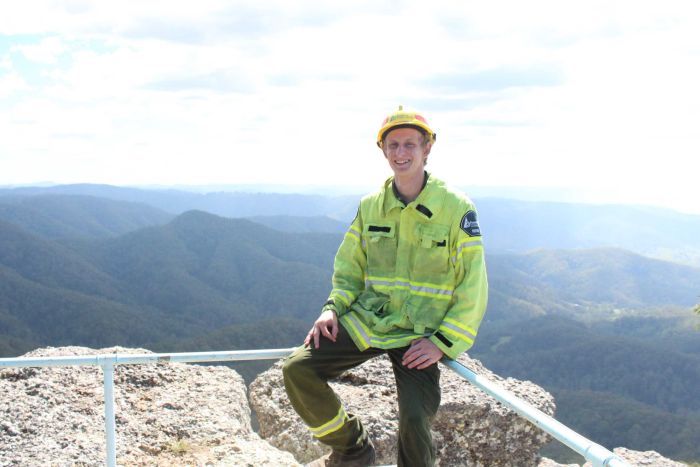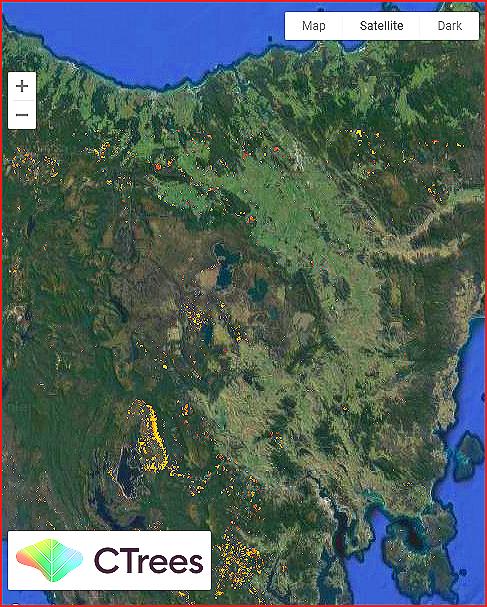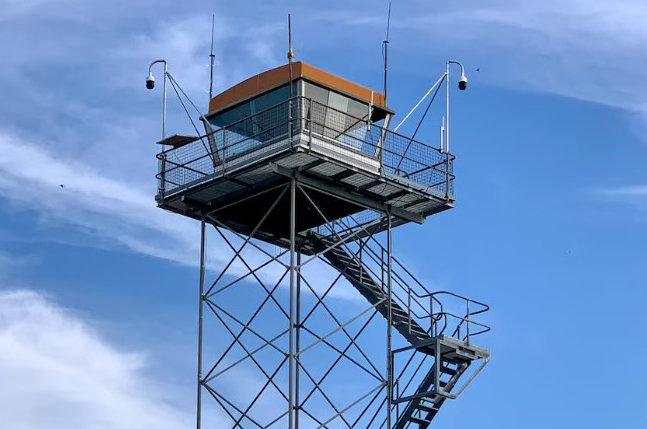
When any private forest companies burn, their burns disappear. They do not appear on the 'burning now' map. How good is that?
Tasmania is hiding its burns from the public.
Even when they "get it right" Tasmanian's still have to breathe their smoke.
In Tasmania it is impossible to predict wind direction. The wind quite often blows to all four points of the compass in one day. If a burn is lit in the morning, later in the day large communities are being smoked out. There are many burns alight at once and the burns last for days and cannot be extinguished. The Bureau of Meterology acknowledges the short comings of smoke modelling with all methods available to us at this time.
Forestry's aim is to put the maximum amount of smoke they can into an airshed. They do not worry about what other burns are taking place in the state at the time.
"Fire is a vital and necessary part of the life cycle of Tasmania's eucalypt forests and by conducting these burns we are mimicking the natural process.,"
This is absolute nonsense. Forestry are burning on a much shorter rotation than any natural fire could occur.
Then there was this...
It was reported in the Mercury newspaper (3/9/2008) by Forestry Tasmania’s assistant general manager Michael Wood that the fuel wood being transported to Japan would have just been burnt. He claims there could be up to a million tonnes a year of this fuel wood spread across Tasmania.
Bob Gordon states in the same article,”… instead of wood in forests being burnt to create a seedbed for eucalypts..” he would like to see it feeding wood fired power stations.
What does this tell us?
That these so called forestry regeneration burns are not regeneration burns at all. They are forestry operation residue burns or rubbish burns because if they can send the wood to Japan or use it in power stations then they are now stating there is no need for eucalypt forests to be regenerated by fire, there is no need for an ash seedbed, there is no need for smoke!.
Forestry do not have to burn. Plantation seedlings are raised in nurseries, so why all the smoke?
The forest industry claims the burns are "regeneration burns."
The burns being done are mostly residue burns, not regeneration burns. Forestry are burning rubbish left behind after they have logged or cleared an area. In other words forestry can not even clean up their own mess, without making another mess.
In haste to replant, the forest industry sets fire to their residue when a lot of it is still green.
What is "cost shifting? Cost shifting is when forestry perform residue burns to save themselves money, and then transfers the associated cost onto our health system, community, environment, and so on.
There is no reason to burn or to produce harmful smoke when other cleaner alternatives exist.
If the same area is to be burnt, this would have the effect of lengthening the burning season. It would also create a not-so-visable smoke haze all the time, meaning people would be breathing harmful smoke without knowing it for extended periods and this is a very serious matter for everyone.
This would be like giving a smoker 100 cigarettes in one hit and telling them not to smoke them all at once!
There is a big difference between Reduction, Regeneration and Residue/Rubbish burns.
Most of the smoke we are breathing comes from forestry Residue.
Planned Burns must stop completely. There are other smokeless methods available to forestry to get rid of their Rubbish.
Planned clearing does not mean planned burning.
Deforestation practices in Tasmania cause harmful air pollution.
Smoke levels across Tasmania could be substantially reduced by curtailing the constant, deliberate burning of rainforests, which rarely burn naturally.
This trial is not compulsory.
It has failed to deliver clean air each year.
People have still suffered severe smoke inhalation. Why?
The burn lasted for days http://cleanairtas.com/phpbb/viewtopic.php?f=3&t=72
Here are Forestry Tasmania's burns for earlier in 2010
Here are the private forestry burns but you will notice how FT claim these industries do not have to state whether the planned burns were actually lit.
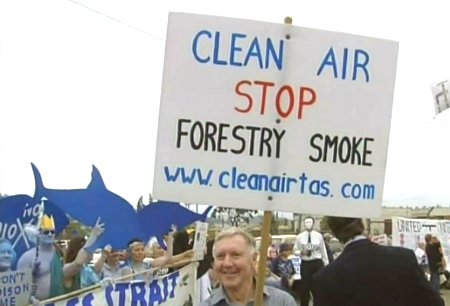
Gunns were proposing to build a 2.5 billion dollar pulp mill in the Tamar Valley.
If it was natural for human beings and other forms of life to breathe wood smoke we would all be born with hospital-grade filters attached to our air intakes." - Clive M.Stott 2013
"Allowing Forestry Tasmania to be in charge of ‘fuel reduction’ burns is like letting kids loose in a lolly shop!"
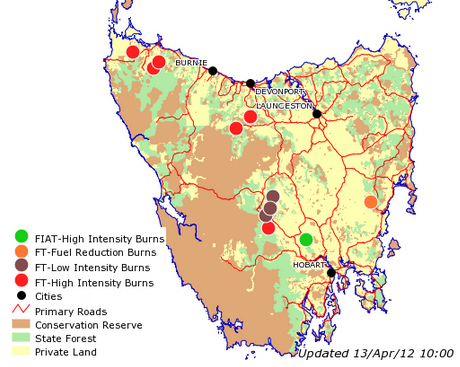



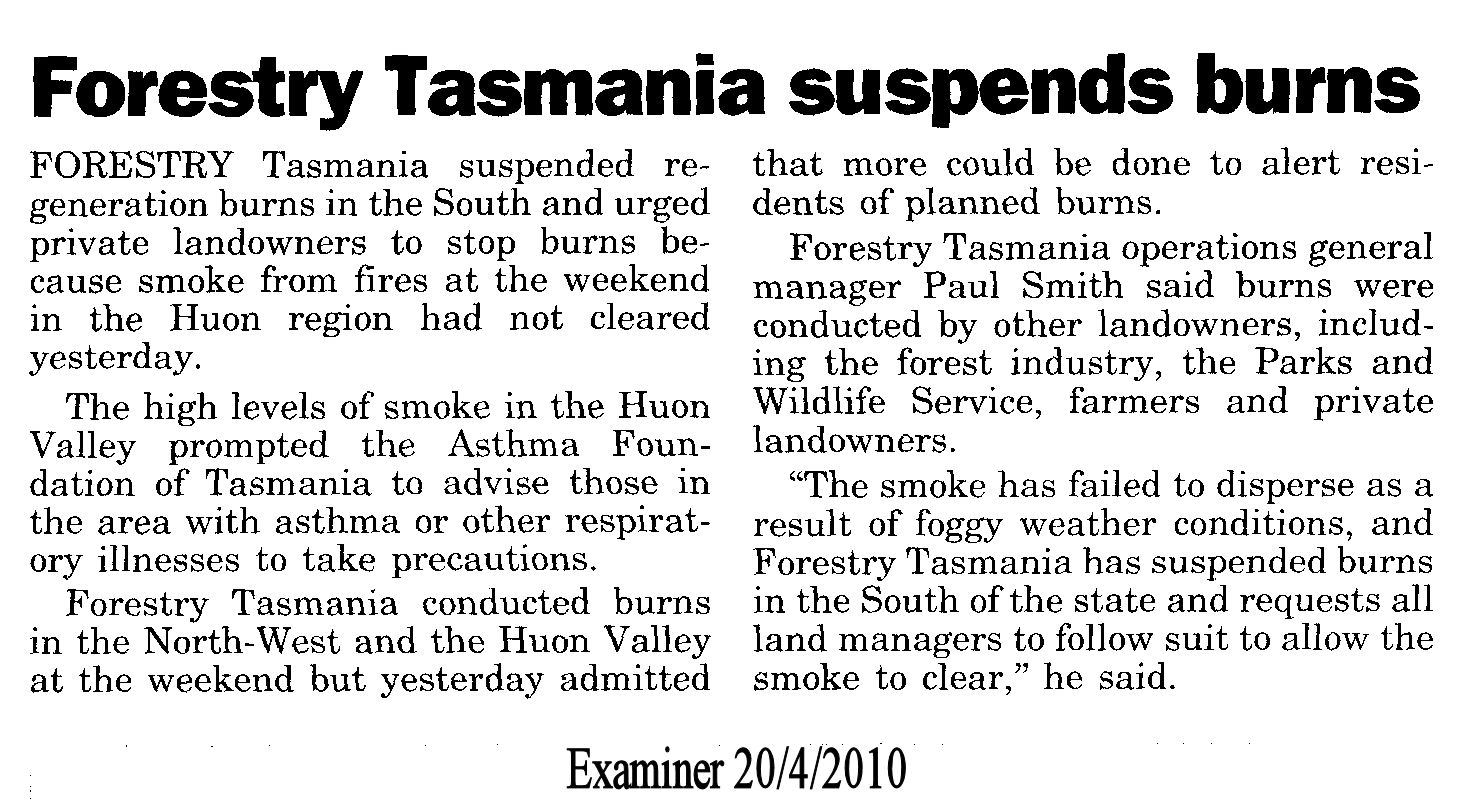
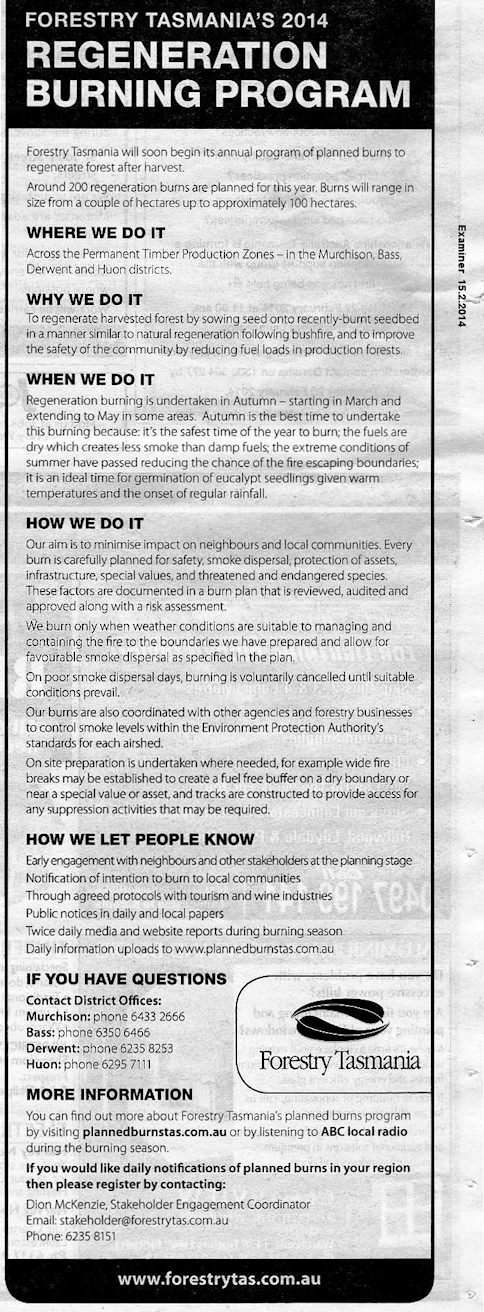
The reason Forestry Tasmania burns is to reduce fuel loads in their production forests, i.e., to get rid of their waste by burning it.
The smoke is suffocating - Miranda Gibson and the Observer Tree : Day 127


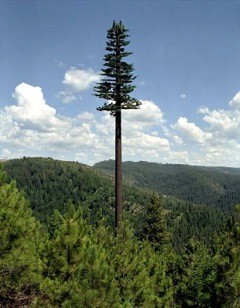
Try chipping this one!
Go here to see why
Go here to view FT's interactive map of deliberate burns and chemical applications.
The future for biomass energy from our native forests
Burning wood increases global warming more than coal
Click on the picture above for the ABC story
The protest followed on from Clive Stott's smoke flare being set off in the Environment Minister's office HERE

‘In 2017 alone Forestry Tasmania burnt more than 3500 hectares of Tasmanian forests after logging, releasing 2.4 million tonnes of C02 into Earth’s atmosphere,’ Jenny Weber said.
‘Every Autumn, Forestry Tasmania burns whatever’s left after industrial logging has destroyed vast tracts of our island’s magnificent forests. These firestorms are an outdated tool used to engineer the forest, killing off the rainforest species and wildlife habitat that make Tasmania’s native forests so unique,’
Then watch the old video Two Visions
The Fenner School of Environment and Society – ANU.
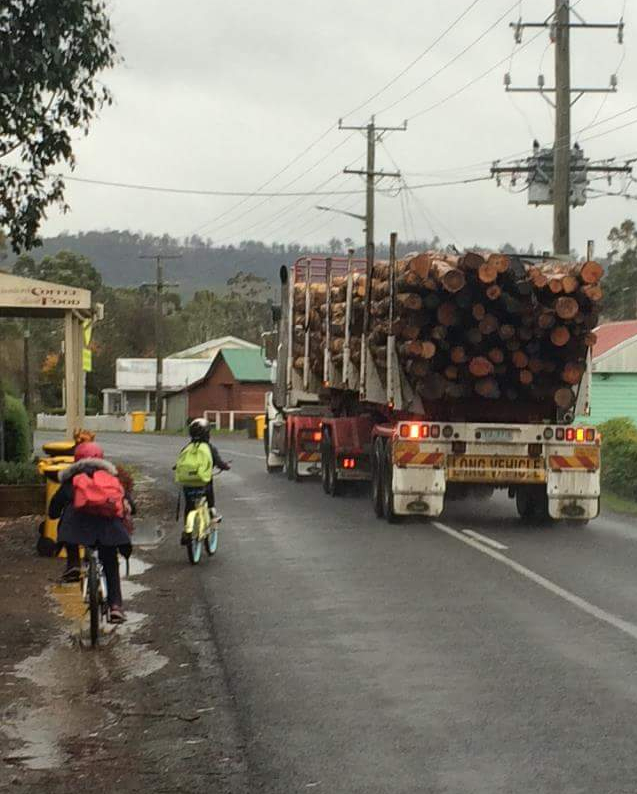
Push the kids into the gutter. Cross over onto the wrong side of the road!
Story HERE
"The only factor to keep in mind is that the size of the burn is not necessarily an indicator of the smoke produced because not all treated area is burnt. In addition, other factors such as weather conditions, fuel conditions and the intensity of the fire will determine the amount of smoke produced.
Burns will be conducted when conditions are suitable (including weather and site conditions and smoke dispersal) and therefore the timing of burns is not known well in advance due to the accuracy of long range weather forecasting."
So why are our fires not put out in their infancy and left to burn and smoke?
The head of the fire should be attacked aggressively in its early stages until it is out.
Click on the photo to read the ABC report.
"The study highlights that prescribed burning can theoretically mitigate wildfire, but that an unrealistically large area would need to be treated to affect fire behaviour across the island."
...prescribed fire had the opposite effect (fire-follows-fire)"
"Modelling shows nearly a third of the state would need to be burned to have significant impact on wildfire threat
Prescribed burn-offs have little impact on reducing the extent and intensity of bushfires"
in Zimbabwe.
There are so many things wrong with the deliberate lighting of fires.
Read the above article....
"Prescribed burn-offs have little impact on reducing the extent and intensity of bushfires"
Pyromania is a disease.
Burning fossil fuels, in combination with destruction of carbon sinks due to deforestation and other activities, has contributed to more and more carbon dioxide building up in the atmosphere – more than can be absorbed from existing carbon sinks such as forests.
The more you burn the more you will have to burn.
Bushfires, wildfires, convert our landscape to be fire tolerant.
These fires must be jumped on and put out in their infancy with sufficient resources.
Plannedburning has the same effect.
NSW Fire Chief - Precribed Burning is not the Panacea and HERE
Old fire chief rejects critism on shortfall in hazard reduction burns
Victorian CFA fire chief says calls for more burns emotional load of rubbish
The lower flammability of older forests, and their importance as an increasing store of carbon, suggests that a cessation of logging outside plantations might have considerable benefits.
Multiple independent, peer reviewed studies show logging forests after bushfires increases future fire risk and can render the forest uninhabitable for wildlife for decades or even centuries.

How ludicrous the suggestion that more hazard reduction burns can prevent or reduce such wildfire activity.
How ludicrous is it when forestry tell us high intensity burn smoke is not dangerous because it goes up into the stratosphere
research associate from UTAS School of Environmental Science
There were an estimated 429 smoke-related premature deaths, 3,230 hospital admissions for heart and breathing disorders, and 1,523 emergency department visits for asthma as a result of the 2019/20 mainland East coast bushfires.
Smoke costs alone have been estimated to be $1.95 billion.
This is what a team of leading researchers from the Menzies Institute for Medical Research at the University of Tasmania, the University of Sydney, the University of New South Wales and the University of Melbourne have found
https://www.mja.com.au/journal/2020/213/6/unprecedented-smoke-related-health-burden-associated-2019-20-bushfires-eastern?
Smoke from California fires may have killed more than 1,000 people
More pernicious smoke so they can get rid of their trash.
Residents aren't even allowed to foul the air with wood heater smoke or back yard burning smoke and yet forestry can do it on a large scale, smoking out whole air sheds or sending their garbage up into the stratosphere adding to climate change.
They are just using our air as a sewer. More burning equals more burning.
The Forest Practice Authority's Coordinated Smoke Management Strategy (CSMS) has been designed to allow forestry to put the MAXIMUM amount of smoke into our 11 air sheds.
Eucalypt seedlings can be grown in nurseries. Forestry don't need to burn the landscape and kill the native fauna and flora to grow gum trees; they will grow in a crack in the bitumen.
Forico also has added 23 of their planned burns so far.
By deliberately setting fire to their plantation rubbish, it could be argued any money saved is directly cost-shifted to providing life-long care to smoke-caused victims.
Can our over-stretched health system cope with more deliberate plantation burning, more smoke, and more climate change?
Wine and beer producers north of Hobart are pleading with authorities to stop planned forestry burns they say threaten their livelihoods
https://www.abc.net.au/news/2021-03-11/wine-beer-producers-angry-over-planned-forest-burns/13237742
This procedure has been developed by the Tasmanian Forest Industry Fire Management Committee (FIFMC). The objective is to minimise the incidence of wildfire resulting from forest and related operations. It outlines minimum fire equipment requirements for forest operations and procedures to follow to reduce the risk of fire. A copy of this procedure should be on site at all times
An aggressive aerial attack has helped tamp down an emerging wildfire off Brock Road in North Pole. Retardant-dropping air tankers and water bombing aircraft have pacified the upstart Brock Road Fire after it ballooned in size from one-half acre to an estimated 50 acres in two hours.
At 7 p.m., the fire was not putting up any real visible smoke…
After the fire seemed to be out, high winds whipped it back to life.
Ann Appel, 51, was among worried residents who dialed 911.
“It’s blowing smoke right over my house,” she told an emergency dispatcher.
“Yeah, it’s about 5 acres (2 hectares) and growing, so they’ve got crews on the way,” the dispatcher replied.
Appel thanked the operator and hung up. Her body was later found in the ashes of her home.
There are other way than burning to achieve fuel reduction.
Empirical analyses of the factors in influencing fire severity in
southeastern Australia - DAVID LINDENMAYER ,CHRIS TAYLOR, AND WADE BLANCHARD
Our analyses suggest that forests managed for timber production near settle-
ments may be at increased risk of high-severity fire. This is because logging resets stand age to zero, after which there is a subsequent period of increased probability of high-severity fire, particularly under extreme fire weather conditions. Therefore, policies to maintain cover of older forest near settlements should be considered.
Planned Burning
As part of the Planned Burning Program for 2021, around 175 burns are planned for this year across Permanent Timber Production Zone (PTPZ) land, ranging in size from a couple of hectares up to approximately 100 hectares.
Fire Management
“While a prescribed burn can cause inconvenience at times - particularly the smoke that comes off it - Mahoney said that the controlled burns are...”
Forestry don’t get it. They can’t seriously believe their smoke just causes a little old inconvenience at times? Asthma, COPD, Heart Attacks, cancer, and the list goes on. These are just more than an inconvenience. Forest smoke is like any other smoke it shortens lives, and they keep doing it over and over with their planned burns to achieve what? It doesn’t stop fires running in times of climate change. All it does is make people ill and push up the health department budget. Stop burning stuff. There are smokeless ways to achieve fuel reduction and to protect ecosystems. Click HERE
Co-author and fire ecologist, Professor David Bowman said that although the impacts of smoke from individual prescribed fires was much lower than that associated with severe bushfires, their cumulative impacts were similar because of the much greater frequency of prescribed burns.
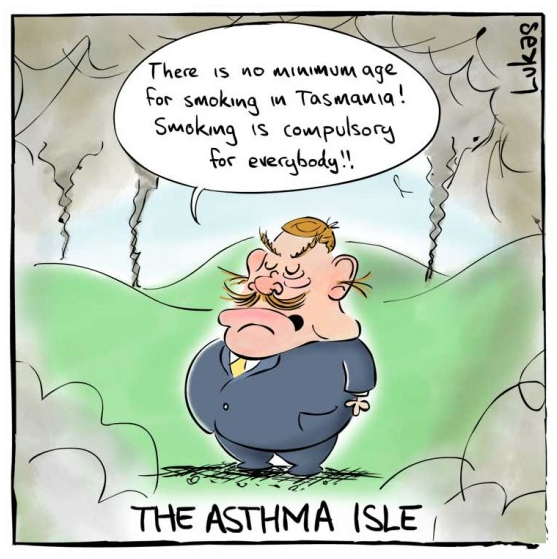
Simard said the work of her students shows a need to re-think clear-cutting. Studies have shown forest practices contribute up to 20 per cent of greenhouse gases worldwide, she added.
Carbon is being stored in trees, plants, debris and soils, and we are losing most of that with clear-cutting, she says.
“We’re doing that all across our country, and we’re doing it all across the world. People who are well informed about the current climate of climate change and biodiversity loss are saying, no, the rules of the day are changing quickly, and we don’t want this anymore.”

"The inhalation of atmospheric aerosol is linked to the onset of cardiovascular and cerebrovascular diseases including myocardial infarctions, ischemic stroke and heart failure," says Kavouras. "To improve air quality, we must look beyond our backyard, we must think regionally and globally and act appropriately.
Scientists hope the belated listing of fires as a threat to forest species can stop the destructive use of hazard-reduction burning. By Karen Middleton.
The Saturday Paper - July 16 2022
At first glance, one might think that logging and then removing fallen trees would reduce fire risks. Why do peer-reviewed scientific studies show that the opposite is actually the case? The Age-July 16, 2022. Professor.David Lindenmayer
Charlie Jaay explores a terrifying crisis within a crisis — misplaced and misleading tree-planting initiatives which, rather than mitigating the climate emergency, compound it, threatening communities and ecosystems.
Each year, 10 million hectares of natural forest are lost worldwide, while fast growing industrial monoculture plantations of uniform species rapidly expand.
‘If a natural forest is converted to a plantation, entire ecological communities will be destroyed, species diversity will be massively reduced, and ecological processes will be irrevocably altered’
‘Industrial tree plantations are not forests’, indicates Klaus Schenck, of German NGO Rainforest Rescue. ‘These monocultures are green deserts which destroy biodiversity, soils, water supplies and the livelihoods of the people.’
The Forest Practices Authority (FPA) co-ordinates planned burns in Tasmania.
It uses the Coordinated Smoke Management System to do this.
Alleged breaches of forest practices plans are investigated by the FPA. Alleged breaches of air quality standards are investigated by EPA.
Editor's comment: But they can make as much smoke as they like as long as they don't breach the daily average standard. Repeat, the daily AVERAGE standard.
The Coordinated Smoke Management System (CSMS), designed to reduce smoke pollution levels near populated areas, is a voluntary system currently used by the forest industry, Tasmania Fire Service (TFS) and Parks and Wildlife Service (PWS).
18.12.2022
How Often Should We Burn in Tasmania?
Check out what has been proposed - you will be amazed
Full document download Here
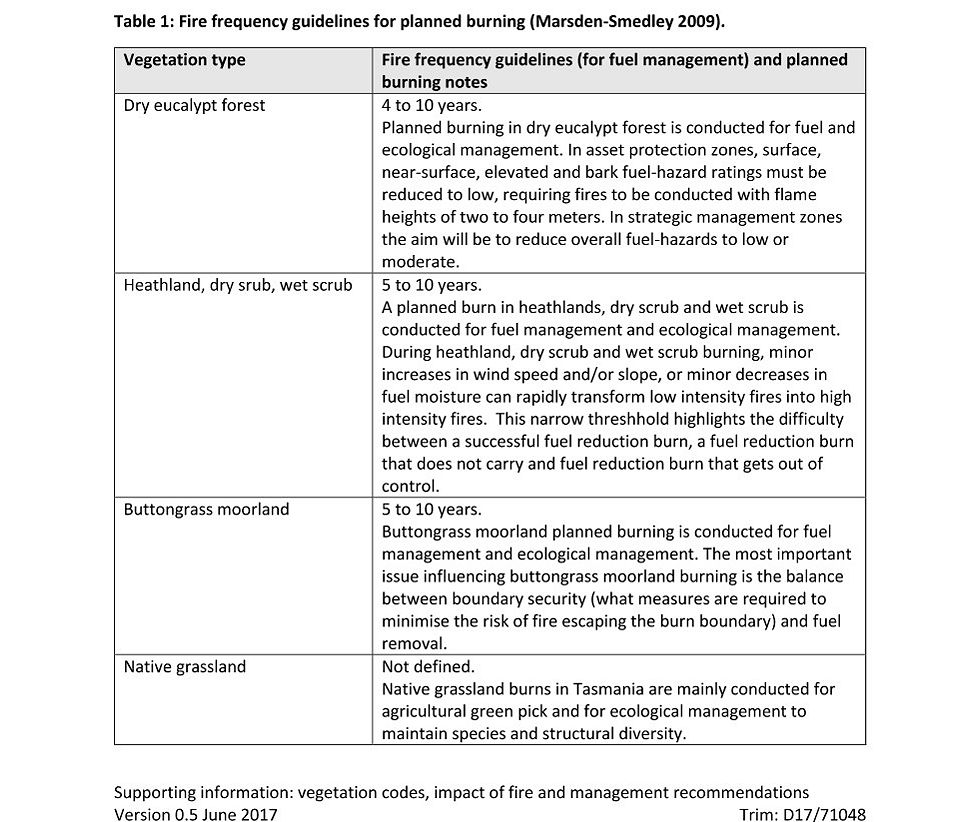
Gray explains that “Canada does not carry out arson operations sufficiently, as it burns about 10 thousand hectares annually, in British Columbia,” which is less than what New Jersey burns, for example.
Correction to National Pollution Inventory (NPI) figures
Pie chart HERE
Impact of biomass burning sources on seasonal aerosol air quality

Explore forest disturbance alerts from 2018 to present by zooming on an area of interest, selecting a custom area, or choosing an administrative area. Color-coded pixels represent forest disturbance alerts at a minimum mapping unit of 0.05 hectares.
Click on the above screenshot.
Professor David Lindenmayer AO is a world-leading expert on forest conservation and is ranked among Australia's top 50 scientists.
It's time we realised the value of leaving native forests standing.

